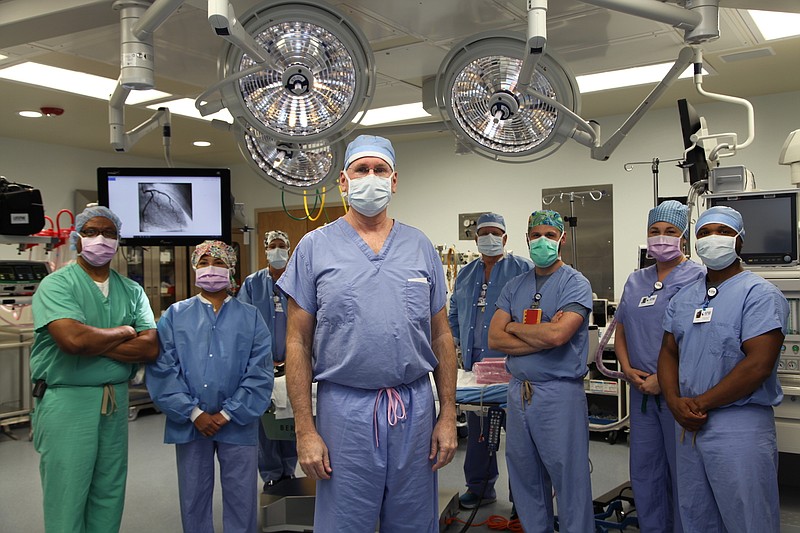National Park Medical Center opened a new cardiovascular surgery suite with improved technology and started using a new method to treat abdominal aortic aneurysms to better the lives of patients in the region.
The new surgery suite includes high-resolution monitors for improved visibility of the heart during surgery and is used for a variety of different operations.
The improved visibility gives surgeons better insight on all procedures but especially on minimally invasive surgeries like those that use grafts.
"Obviously from anesthesia and everybody else in the room it helps them as well because it helps them to be more of a part of the case when they have the ability to be involved and see other things," cardiovascular and thoracic surgeon Dr. Daniel McCoy said. "In fact, some of our nurses say, 'Oh, I never could see that before and I now can see what you're doing and it keeps me involved.'"
The ability to have a less-invasive procedure means a quicker recovery time and fewer incisions for patients.
In 2017, NPMC opened its Heart and Vascular Center, which McCoy said is what originally made a major difference in treatment at NPMC.
Video not playing? Click here https://www.youtube.com/embed/rstYlGjq-Zo
"This is really just an extension of that which means that it just upgrades the modern approach," McCoy said. "So from a patient standpoint the most likely difference would be you might be able to have a minimally invasive procedure where previously you would have had to have a more invasive procedure. In other words, knives and bigger openings."
McCoy said the suite compares to suites in major cities like Dallas and Atlanta.
"It's important to have one in Hot Springs because it's very difficult to travel when you have health problems," McCoy said. "If you have health problems it's very difficult to travel because number one, what we do isn't generally an outpatient surgery. So if you can have quicker recovery that's better and the same modern treatment that you get or receive anywhere."
One important procedure performed in the new surgery suite is the ALTO Abdominal Stent Graft System used to treat patients with abdominal aortic aneurysms.
Aneurysms can occur at many points in arteries in the body. They happen when the wall of an artery gets thinner and the artery then expands. Common places aneurysms occur are in the abdominal aorta, the ascending aorta and in the brain. Aneurysms get especially dangerous the more they grow and can be fatal if one ruptures.
Abdominal aortic aneurysms can be treated by a traditional, more invasive open surgical repair. In the open surgical repair, the aneurysm is completely eliminated and replaced with a graft but the recovery time is longer and the surgery comes with a higher chance of death.
Abdominal aortic aneurysms can also be treated through endovascular repair. Endovascular repair is less invasive and involves small cuts or incisions in each groin. An endovascular stent graft is put into the body through the small incisions in the groin.
Although an endovascular repair is less invasive, in patients that have an endovascular repair, the aneurysm still has to be tracked after the procedure. This is because an endovascular repair does not get rid of the aneurysm, it just diverts blood flow from the aneurysm.
Patients who have an endovascular repair must have follow-up examinations long-term. About 10% of those who have an endovascular repair will need to have something done again in the future.
"So the traditional aneurysm repair, why wouldn't we just do that on everybody so we didn't have to follow? The reason is, in the regular population of patients (traditional repair) has about a 3 or 4% risk of death," McCoy said. "It's a very morbid surgery because we go into somebody's belly. It takes about five or six days for their guts to wake up. They have to have a tube in their nose. It's very painful."
Many patients with aneurysms are long-term smokers and many have emphysema or chronic obstructive pulmonary disease.
"When you open their belly they don't breathe very well," McCoy said. "So for that reason they're set up to get pneumonia, to really never get better. It's a real morbid operation. By some comparison aneurysm surgery would have a 3 or 4% risk of mortality. A standard heart bypass surgery would have a less than 1% risk of mortality. Also for young male patients open aneurysm surgery can be associated with impedance."
The new surgery suite helps during the ALTO operation.
"One of the nice capabilities about our operating suite is it has modern monitors, modern equipment that we can use to implant devices like this," McCoy said. "Which we were already doing obviously but this makes it easier to do because it gives me better visualization of how I can use the grafts."
McCoy said the ALTO graft is good for the region because of the quicker recovery time and the lower mortality rate.
He emphasized the seriousness of aneurysms and why they need to be treated.
"Aneurysms are silent killers," McCoy said. "A ruptured aneurysm is one of the most common reasons people in America die. If you have a close family relative that had an aneurysm or you are a current or former smoker then you should probably be screened for an aneurysm."

